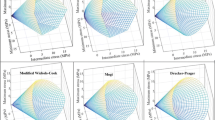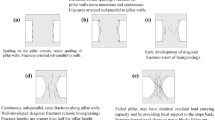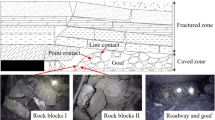Abstract
Study of intact rock failure criteria is an important topic in rock mechanics. In this study, applicability of nine different intact rock failure criteria is investigated for intact coal strength data. PFC3D modeling was used to simulate the laboratory polyaxial tests for cubic intact coal blocks of side dimension 110 mm under different confining stress combinations. A modified grid search procedure is proposed and used to find the best-fitting parameter values and to calculate the coefficient of determination (R 2) values for each criterion. Detailed comparisons of the nine criteria are made using the following aspects: R 2 values, σ 1 − σ 2 plots for different σ 3, shapes on the deviatoric plane, linearity or nonlinearity on the meridian planes. Through the comparisons of R 2 values, σ 1 − σ 2 plots and meridian lines, the modified Wiebols–Cook and modified Lade criteria were found to fit the intact coal strength data best. The nine failure criteria are categorized into three types based on the appearances on the deviatoric plane.


































Similar content being viewed by others
Abbreviations
- σ 1, σ 2, σ 3 :
-
Major, intermediate and minor principal stresses at failure, respectively
- σ 1′, σ 2′, σ 3′:
-
Major, intermediate and minor effective principal stresses at failure, respectively
- I 1, I 3 :
-
First and third invariant of stress tensor
- I 1′, I 3′:
-
Modified first and third invariant of stress tensor
- J 2 :
-
Second invariant of deviatoric stress tensor
- σ oct :
-
Octahedral normal stress or mean stress
- τ oct :
-
Octahedral shear stress
- σ m,2 :
-
(σ 1 + σ 3)/2
- σ ci :
-
Uniaxial compressive strength of the intact rock
- σ ti :
-
Uniaxial tensile strength of the intact rock
- σ bi :
-
Strength of the intact rock under triaxial extension stress state for σ 3 = 0
- τ :
-
Shear stress
- σ n :
-
Normal stress
- τ 13 :
-
Major principal shear stress
- τ 12 :
-
Intermediate principal shear stress or minor principal shear stress
- τ 23 :
-
Intermediate principal shear stress or minor principal shear stress
- σ 13 :
-
Normal stresses acting on the τ 13 plane
- σ 12 :
-
Normal stresses acting on the τ 12 plane
- σ 23 :
-
Normal stresses acting on the τ 23 plane
- q :
-
Material constant determined by a certain function of the coefficient of friction in the W–C criterion
- c 0 :
-
Cohesion of the intact rock
- φ :
-
Internal friction angle of the intact rock
- m b :
-
Hoek–Brown constant for the rock mass
- m i :
-
Hoek–Brown constant for the intact rock
- s, a :
-
Constants depending on the rock mass characteristics
- D :
-
Disturbance factor
- GSI :
-
Geological Strength Index
- α, k :
-
Material constants of the D–P criterion
- ρ c , ρ t :
-
Compressive and tensile meridian on the deviatoric planes
- κ :
-
Material constant depending on the density of the soil in Lade–Duncan criterion (1975)
- p a :
-
Atmospheric pressure
- m′, η 1 :
-
Material constants of the modified Lade criterion (1977)
- S :
-
Material constant related to the cohesion and internal friction angle of the rock in the modified Lade criterion (1999)
- η :
-
Material constant representing the internal friction of the rock
- A, B, C :
-
Parameters in the modified W–C criterion
- β :
-
Constant smaller than 1 in Mogi (1967) criterion
- C′:
-
Parameter related to c 0 and φ in the linear unified failure criterion
- δ :
-
Parameter related to φ in the linear unified failure criterion
- b :
-
Intermediate stress parameter in both linear and nonlinear unified failure criteria
- ω :
-
Ratio of σ ci to σ ti for the intact rock in the linear unified failure criterion
- θ :
-
Lode angle
- ρ, ξ :
-
Abscissa and ordinate of the plots on the meridian planes
References
Benz T, Schwab R (2008) A quantitative comparison of six rock failure criteria. Int J Rock Mech Min 45:1176–1186. doi:10.1016/j.ijrmms.2008.01.007
Bieniawski ZT (1976) Engineering classification in rock engineering. In: Proceedings of the symposium on exploration for rock engineering, Johannesburg. pp 97–106
Brown ET (1970) Strength of models of rock with intermittent joints. J Soil Mech Found Div ASCE 96(6):1935–1949
Colmenares LB, Zoback MD (2002) A statistical evaluation of intact rock failure criteria constrained by polyaxial test data for five different rocks. Int J Rock Mech Min 39:695–729. doi:10.1016/S1365-1609(02)00048-5
Drucker DC (1973) Plasticity theory strength-differential (SD) phenomenon, and volume expansion in metals and plastics. Metall Trans 4(3):667–673. doi:10.1007/BF02643073
Drucker DC, Prager W (1952) Soil mechanics and plastic analysis or limit design. Q Appl Math 10(2):157–165
Ewy RT (1999) Wellbore-stability predictions by use of a modified Lade criterion. SPE Drill Complet 14(2):85–91. doi:10.2118/56862-PA
Garvey R, Ozbay U (2011) Computer-aided calibration of PFC3D coal samples using a genetic algorithm. Continuum and distinct element numerical modeling in geomechanics, Itasca Int. Inc., Minneapolis, MN, USA, pp 493–499
Handin J, Heard HC, Magouirk JN (1967) Effects of the intermediate principal stress on the failure of limestone, dolomite, and glass at different temperatures and strain rates. J Geophys Res 72(2):611–640. doi:10.1029/JZ072i002p00611
He PF, Kulatilake PHSW, Liu DQ, He MC (2016) Development of a new three-dimensional coal mass strength criterion. Int J Geomech. doi:10.1061/(ASCE)GM.1943-5622.0000741
Hoek E (1968) Brittle failure of rock. In: Stagg KG, Zienkiewicz OC (eds) Rock mechanics in engineering practice. Wiley, New York, pp 99–124
Hoek E, Brown ET (1980) Empirical failure criterion for rock masses. J Geotechn Eng Div ASCE 106(GT9):1013–1035
Hoek E, Brown ET (1997) Practical estimates of rock mass strength. Int J Rock Mech Min 34(8):1165–1186. doi:10.1016/S1365-1609(97)80069-X
Hoek E, Wood D, Shah S (1992) A modified Hoek–Brown criterion for jointed rock masses. In: Hudson JA (ed) Eurock 1992: rock characterization: ISRM symposium, Chester, U.K. Thomas Telford, London, pp 209–213
Hoek E, Kaiser PK, Bawden WF (1995) Support of underground excavations in hard rock. A.A. Balkema, Rotterdam
Hoek E, Carranza-Torres C, Corkum B (2002) Hoek–Brown failure criterion-2002 edition. In: Proceedings of NARMS-Tac conference, Toronto, vol 1, pp 267–273
Itasca (2003) PFC3D user’s manual, version 4.0. Itasca Consulting Group Inc., Minneapolis
Itasca (2008) 3DEC user’s guide. Itasca Consulting Group Inc., Minneapolis
Kulatilake PHSW, Park J, Malama B (2006) A new rock mass failure criterion for biaxial loading conditions. Geotech Geol Eng 24(4):871–888. doi:10.1007/s10706-005-7465-9
Lade PV (1977) Elasto-plastic stress-strain theory for cohesionless soil with curved yield surfaces. Int J Solids Struct 13(11):1019–1035. doi:10.1016/0020-7683(77)90073-7
Lade PV, Duncan JM (1975) Elasto-plastic stress-strain theory for cohesionless soil. J Geotech Eng Div ASCE 101(10):1037–1053
Ma X, Rudnicki JW, Haimson BC (2014) True triaxial tests in two porous sandstones: experimental failure characteristics and theoretical prediction. In: Proceedings of 48th US rock mechanics/geomechanics symposium, American Rock Mechanics Association, Minneapolis, MN
Mogi K (1967) Effect of the intermediate principal stress on rock failure. J Geophys Res 72(20):5117–5131. doi:10.1029/JZ072i020p05117
Mogi K (1971) Fracture and flow of rocks under high triaxial compression. J Geophys Res 76(5):1255–1269. doi:10.1029/JB076i005p01255
Potyondy DO, Cundall PA (2004) A bonded-particle model for rock. Int J Rock Mech Min Sci 41(8):1329–1364. doi:10.1016/j.ijrmms.2004.09.011
Singh B, Goel RK, Mehrotra VK, Garg SK, Allu MR (1998) Effect of intermediate principal stress on strength of anisotropic rock mass. Tunn Undergr Space Technol 13(1):71–79
Wang RR, Kemeny JM (1995) A new empirical failure criterion for rock under polyaxial compressive stresses. In: Proceedings of 35th U.S. rock mechanics symposium, American Rock Mechanics Association, Reno, Nevada, pp 453–458
Wiebols GA, Cook NGW (1968) An energy criterion for the strength of rock in polyaxial compression. Int J Rock Mech Min 5(6):529–549. doi:10.1016/0148-9062(68)90040-5
Yu MH (2002) Advances in strength theories for materials under complex stress state in the 20th century. Appl Mech Rev 55(3):169–218. doi:10.1115/1.1472455
Yu MH (2002) A unified failure criterion for rock material. Int J Rock Mech Min 39(8):975–989. doi:10.1016/S1365-1609(02)00097-7
Zhou SH (1994) A program to model the initial shape and extent of borehole breakout. Comput Geosci 20(7/8):1143–1160. doi:10.1016/0098-3004(94)90068-X
Acknowledgements
The research was funded by the National Institute for Occupational Safety and Health (NIOSH) of the Centers for Disease Control and Prevention (Contract No. 200-2011-39886) and the State Key Laboratory for Geomechanics and Deep Underground Engineering, China University of Mining & Technology, Beijing (Contract No. SKLGDUEK1416).
Author information
Authors and Affiliations
Corresponding author
Rights and permissions
About this article
Cite this article
He, Pf., Kulatilake, P.H.S.W., Yang, Xx. et al. Detailed comparison of nine intact rock failure criteria using polyaxial intact coal strength data obtained through PFC3D simulations. Acta Geotech. 13, 419–445 (2018). https://doi.org/10.1007/s11440-017-0566-9
Received:
Accepted:
Published:
Issue Date:
DOI: https://doi.org/10.1007/s11440-017-0566-9




